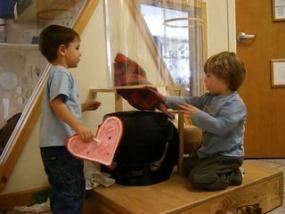Designing a Rich Problem Solving Setup

Henry and Caleb, at Boulder Journey School, watch how feathers and fabric behave differently in two wind tubes made from fans and Plexiglas. The fan on the right pushes less air than the one on the left. This setup has many variables that present opportunities for discovery. The technical skills needed for experimenting are minimal and the effects are immediate, obvious and often dramatic. The design of the space allows several children to play at the same time and to enter the play at their own level.
Watch this clip to see how the setup encourages discovery. Pay particular attention to the strategies Caleb and Henry use. Here are a few:
1. Hold the feather in the wind, observe it flutter, then release
2. Catch the feather before it hits the ground
3. Use the other fan when the fabric does not ascend
4. Place hand flat on the fan to cause the fabric’s descent
5. Angle the cardboard heart to capture the air stream
6. Bundle the fabric to increase the surface area in the air stream
7. Get a new piece of fabric when the first falls too far to reach
8. Call a friend when the fabric gets trapped in a vortex
See if you can find any examples of an improvement in a strategy, something that you would call learning. Consider how you might improve this setup or how you might create a provocation for children to engage in more collaborative play.
Keywords: Threes, Child-Object, Cause/Effect, Force, Exploration
Length of stand alone master video clip: 2 minutes 26 seconds
